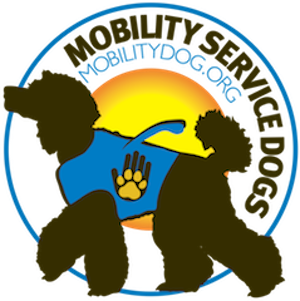The Leash You Can Do
Little Girl Walking a Service Dog On a Leash (Courtesy: MobilityDog.org)
The correct leash is an important factor in how you and your dog experience your walks together. It can make the difference between a relaxing, enjoyable outing and a frantic tug-of-war. When choosing a leash, consider the size and training level of your dog, the activities you’ll be sharing, and the comfort of both dog and handler.
Standard Flat Leashes
Standard flat leashes are the kind you see most often. They’re usually made of a tough nylon weave and are 4 to 6 feet long. They are generally inexpensive, strong, waterproof, and washable. Standard leashes with an extra handle closer to the dog are useful when you’re walking in traffic or areas crowded with people and other dogs.
Rope Leashes
Usually not ropes (more often heavy-duty fabric weaves), these are more robust than flat leashes. They often have leather handles and are easy to grip with two hands. They work well with larger, stronger dogs who sometimes use their weight to lean into their walks.
Group of Service Dogs on Leashes And Handlers (Courtesy: MobilityDog.org)
Chain Leashes
A chain leash has a nylon or leather handle and a chain that comes in a variety of thicknesses. They are particularly strong; dogs who are chewers shouldn’t be able to destroy a chain leash.
Retractable Leashes
The retractable leash contains a nylon tape or cord allowing you to extend the length — sometimes up to 30 feet — and then retract it. The plastic handle usually has a lock, so you can control the length of the extension. Although flexible, retractable leashes (especially when at their longest) don’t give the handler much control over the dog. They work best with small dogs that can easily be reeled in when necessary, or in relatively open spaces with few other dogs or humans.
Long Line Leashes
Similar to a retractable leash, a long line gives your dog extra room to move. However, it doesn’t extend based on the pull of the dog. The handler lets out the leash and loops it back in. Here again, a long leash affords the dog ample freedom to move about but reduces the handler’s control. Best for small or well-disciplined dogs or in situations where an encounter with another dog is unlikely.
Hands-Free Leashes
Hands-free leashes come with an adjustable loop that’s worn around the handler’s waist, with the other end clipped to the dog’s collar or harness. Runners often use these to keep their hands free while moving. This type of leash works best with a dog that is trained (and conditioned) to accompany a hiker or runner.
Double Leashes
If you’re walking two dogs and don’t want to juggle two separate leashes, the double leash is a good option. There is one leash for the handler to hold and a coupler with two collar attachments. These work best with small or medium-sized dogs (or well-trained, disciplined big dogs). Dealing with two big, rowdy animals simultaneously on one leash can be a workout.
Martingale Leashes
A martingale leash is handy to control pulling. It combines a standard leash with a martingale collar. A martingale collar is made with two loops. The larger loop slips onto the dog's neck and a lead is then clipped to the smaller loop. When the dog tries to pull, the tension on the lead pulls the small loop taut, which makes the large loop smaller and tighter on the neck. Properly fitted, the collar will be comfortably loose whenever the dog is not pulling against the leash. A martingale collar enables a handler to hold a dog firmly without choking the animal.
Woman With Mobility Service Dog Wearing Harness And Leash (Courtesy: MobilityDog.org)
Final Thoughts
The control afforded by the right leash makes outings safer and more pleasant for the dog, the handler, and the world at large. Leashes help us train our dogs, keep them safe, and control interactions with other animals and people. Being effectively connected to our dogs increases our awareness of their reactions to the environment and strengthens our bonds with our pooches.
Note: This blog was adapted from: Harriet Meyers, “Dog Leashes 101: These Leashes Were Made for Walking,” American Kennel Club, Dog Leashes 101: Choosing the Right Dog Leash for Your Dog.



